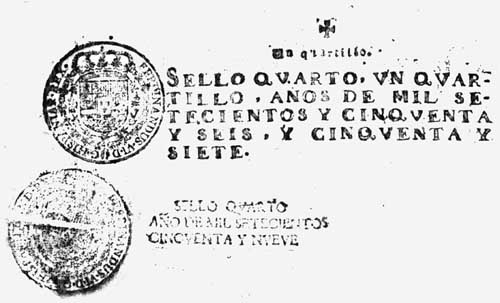
|

|
| H. 1888 to
1898
(Authorized by the Royal Decree of May 16, 1886.)
No specimen has been seen of SELLO 11. The price of this class of stamped paper was fixed at 10c. de peso by Article 1 of the Royal Decree of May 16, 1886. Article 14 of the same decree provided that stamped of the eleventh class should be used for: notes drawn in favor of the Treasury Department for the purchase of State property; copies of deeds issued for the cession of public land; bids for public works services to be rendered either the General or Municipal Governments. It is possible that copies of deed covering the cession of public lands and written on SELLO 11 may be found in the Archives Division of National Library and Museum of Manila. SIZE AND FORM OF PAPEL SELLADO From 1640 until the end of 1887 the size and form of each sheet of stamped paper was as follows:
THE STAMP PRINTED ON PAPEL SELLADO Because no specimen of Philippine stamped paper issued prior 1733 has been seen, very little can be said concerning the design of the stamp prior to that date. The Royal Ordinance of December 15, 1636, by which stamped paper was created for use in Spain provided that the stamp printed at the top of the sheet should consist “of the Royal Coat of Arms and at one side of this the name of the King, his titles, the year for which the paper is valid, the class of the paper, and its value”. The Royal Decree of December 28, 1638, by which the use of stamped paper was extended to all Spanish Colonies, merely provided that “because by the variation and change of the designs of the stamps their authenticity is made more assured, we command that the stamped sheets bearing the said stamps shall not be valid nor be current in the Indies for longer than two years, and that for the succeeding two years other stamps of such design as seems most convenient shall be Printed”. Article 1 of the Royal Cedula of February 12,1830, declared: “There will be six classes of stamps……each will have the inscription which declares the class, the biennial period in which it is to be used, and its value with the Royal arms and the bust of the reigning sovereign”. The bust of the reigning sovereign never appeared however, on any of the stamped paper. In all other respects, the design of the strips conformed to the requirements of the law. On all specimens which have been seen of Philippine stamped paper issued between 1733 and about 1813 the design of the stamp corresponds very closely to the design prescribed by the Royal Ordinance of December 15, 1636, above quoted. 
Figure 1 Figure 1 shows a specimen of the design which was current during this period. It is probable that a similar design was current during the period between 1640 and 1733. Prior to about 1813 the printing was so poorly executed that the label was often difficult to read and has the appearance of having been handstamped with a wood block, The stamp of all classes was printed in black ink. |
|
|
|
|
|
|
|
|
|
|
|
|
|
|
|